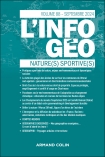
Annales de Géographie n° 695-696 (1-2/2014)
Pour acheter ce numéro, contactez-nous
Recevez les numéros de l'année en cours et accédez à l'intégralité des articles en ligne.
Originaire de la culture vaudou, le Zombie devient à partir de la fin des années soixante un mythe occidental. Le mérite en revient à G.A. Romero qui réinvente un monstre en lui attribuant de fortes connotations socio-politiques et pour lequel l’espace est un élément fondamental. Le Zombie est avant tout une créature urbaine, et s’inscrit au sein des formes ambivalentes de l’urbanisation américaine. Il occupe à la fois les downtowns ainsi que le périurbain. Le corpus choisi, démontre une grande sensibilité dans le traitement de l’espace qui est toujours profondément nuancé (Romero se concentre sur les villes nord-américaines, Boyle sur l’Europe). L’espace des Zombies se caractérise aussi par deux éléments : la ségrégation et la fragmentation. Si les morts-vivants sont une masse homogène qui occupe la surface du territoire, les hommes au contraire perdent leur contrôle de l’espace : ils sont ségrégués dans leurs abris, mais surtout ils sont divisés et en conflit permanent entre eux. Urbaphobie, gated communities, fragmentation, ghettoïsation, disparition de l’espace public, conflits de différentes natures sont tous des éléments récurrents dans le corpus. On peut donc affirmer que les problématiques socio-spatiales sont une clé de lecture fondamentale pour le cinéma des Zombies.
The Zombie is a creature that originated within the colonial context of Haiti and, more specifically, the voodoo mysticism. Resulting from the syncretism between the culture of the African black slaves and the colonial Catholicism, he became a western myth throughout the second half of the XXth century. The basic change between the “original” Haitian Zombie and his western reinvention consists in the loss of his mystic-spiritual feature in favor of a more laic vision which makes the walking-corpse the victim of a virus rather than witchcraft or a spell. The creator of the western Zombie is the American film director G.A. Romero who lays the foundations of the Monster par excellence, with strong political and social connotation and a great importance given to space. The movies which have been analyzed (Romero’s Tetralogy and 28 Days later by the English director Danny Boyle) clearly show how the powerful sociopolitical metaphor embodied by the Zombie may have evident spatial relevance. First of all, the anthropophagous monster is essentially an urban creature. The city, the metropolis, the great agglomerations are his favorite territory. Great attention to the characteristics of urban spaces, particularly the North-American ones, is constantly found in Romero’s movies where the same relevance is given to both downtown and periurban spaces. The city often becomes the Zombie’s favourite habitat whereas the survivors are compelled to move towards a safer place outside the city. The two other basic elements of space in the Zombie cinema are segregation and fragmentation. The Zombie becomes the new dominating creature of the planet and segregation is the price men have to pay for their survival. Be it a Mall, a country house, a bunker or a fortified citadel, the space rather recalls an Early Middle-Ages context, when the price of safety was often the loss of freedom. This opposition lies not only in a simple inside-outside, man/zombie dialectics ; if the Zombies are homogeneous and coherent like their life, Humans appear as continuously torn by conflicts, troubles for the leadership and social conflicts. Their spaces fully reflect this conflictual condition. The humans’ space is fragmented and the opposition ends not only in man versus zombie but also and especially in man versus man. As a matter of fact, in all the movies which have been analyzed the Zombies are able to overcome the barrier because of the survivors’ internal contrasts. If unity is strength, division means defeat. Urbaphobia, gated communities, fragmentation, segregation, limitation of public spaces, different kinds of conflicts, all of them are recurrent elements in the corpus. To sum up, we can claim that the socio-spatial problems of contemporary urban spaces are a basic interpretation of Zombie cinema.

